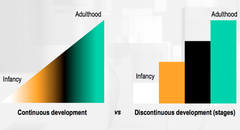answerinfants do not have a self-concept, which is an understanding of who they are
- If you place a baby in front of a mirror, she will reach out to touch her image, thinking it is another baby. However, by about 18 months a toddler will recognize that the person in the mirror is herself. How do we know this? In a well-known experiment, a researcher placed a red dot of paint on children's noses before putting them in front of a mirror (Amsterdam, 1972). Commonly known as the mirror test, this behavior is demonstrated by humans and a few other species and is considered evidence of self-recognition (Archer, 1992). At 18 months old they would touch their own noses when they saw the paint, surprised to see a spot on their faces. By 24-36 months old children can name and/or point to themselves in pictures, clearly indicating self-recognition.
Children from 2-4 years old display a great increase in social behavior once they have established a self- concept. They enjoy playing with other children, but they have difficulty sharing their possessions. Also, through play children explore and come to understand their gender roles and can label themselves as a girl or boy (Chick, Heilman-Houser, & Hunter, 2002). By 4 years old, children can cooperate with other children, share when asked, and separate from parents with little anxiety
- Children at this age also exhibit autonomy, initiate tasks, and carry out plans. Success in these areas contributes to a positive sense of self. Once children reach 6 years old, they can identify themselves in terms of group memberships: "I'm a first grader!" School-age children compare themselves to their peers and discover that they are competent in some areas and less so in others (recall Erikson's task of industry versus inferiority). At this age, children recognize their own personality traits as well as some other traits they would like to have. For example, 10-year-old Layla says, "I'm kind of shy. I wish I could be more talkative like my friend Alexa."
Development of a positive self-concept is important to healthy development. Children with a positive self- concept tend to be more confident, do better in school, act more independently, and are more willing to try new activities
- Formation of a positive self-concept begins in Erikson's toddlerhood stage, when children establish autonomy and become confident in their abilities
What can parents do to nurture a healthy self-concept? Diana Baumrind (1971, 1991) thinks parenting style may be a factor. The way we parent is an important factor in a child's socioemotional growth. Baumrind developed and refined a theory describing four parenting styles: authoritative, authoritarian, permissive, and uninvolved.
- authoritative style: the parent gives reasonable demands and consistent limits, expresses warmth and affection, and listens to the child's point of view. Parents set rules and explain the reasons behind them. They are also flexible and willing to make exceptions to the rules in certain cases—for example, temporarily relaxing bedtime rules to allow for a nighttime swim during a family vacation. Of the four parenting styles, the authoritative style is the one that is most encouraged in modern American society. American children raised by authoritative parents tend to have high self-esteem and social skills.
- authoritarian style: the parent places high value on conformity and obedience. The parents are often strict, tightly monitor their children, and express little warmth. In contrast to the authoritative style, authoritarian parents probably would not relax bedtime rules during a vacation because they consider the rules to be set, and they expect obedience. This style can create anxious, withdrawn, and unhappy kids. However, it is important to point out that authoritarian parenting is as beneficial as the authoritative style in some ethnic groups (Russell, Crockett, & Chao, 2010). For instance, first-generation Chinese American children raised by authoritarian parents did just as well in school as their peers who were raised by authoritative parents
- permissive style: the kids run the show and anything goes. Permissive parents make few demands and rarely use punishment. They tend to be very nurturing and loving, and may play the role of friend rather than parent. - However, there are some positive outcomes associated with children raised by permissive parents. They tend to have higher self-esteem, better social skills, and report lower levels of depression
- uninvolved style: the parents are indifferent, uninvolved, and sometimes referred to as neglectful. They don't respond to the child's needs and make relatively few demands. This could be because of severe depression or substance abuse, or other factors such as the parents' extreme focus on work. These parents may provide for the child's basic needs, but little else. The children raised in this parenting style are usually emotionally withdrawn, fearful, anxious, perform poorly in school, and are at an increased risk of substance abuse
As you can see, parenting styles influence childhood adjustment, but could a child's temperament likewise influence parenting? Temperament refers to innate traits that influence how one thinks, behaves, and reacts with the environment. Children with easy temperaments demonstrate positive emotions, adapt well to change, and are capable of regulating their emotions. Conversely, children with difficult temperaments demonstrate negative emotions and have difficulty adapting to change and regulating their emotions. Difficult children are much more likely to challenge parents, teachers, and other caregivers (Thomas, 1984). Therefore, it's possible that easy children (i.e., social, adaptable, and easy to soothe) tend to elicit warm and responsive parenting, while demanding, irritable, withdrawn children evoke irritation in their parents or cause their parents to withdraw
